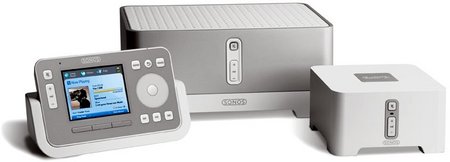Amp-less node adds flexibility to Linux-powered music mesh
Jan 4, 2006 — by LinuxDevices Staff — from the LinuxDevices Archive — views Sonos will demonstrate a version of its Linux-based multi-room music distribution system without a built-in amplifier at the Consumer Electronics Show (CES) in Las Vegas this week. The ZonePlayer ZP80 allows users to integrate existing audiophile equipment with the Sonos Digital Music System, and is… expected to ship this Spring, priced at $350.
Sonos will demonstrate a version of its Linux-based multi-room music distribution system without a built-in amplifier at the Consumer Electronics Show (CES) in Las Vegas this week. The ZonePlayer ZP80 allows users to integrate existing audiophile equipment with the Sonos Digital Music System, and is… expected to ship this Spring, priced at $350.
The Sonos Digital Music System, including the Sonos Controller (left), ZonePlayer ZP100 with 50-Watt amplifier (top), and the new amp-less ZonePlayer ZP80 (right)
(Click to enlarge)
Sonos first announced its Digital Music System at CES last year. The System originally comprised a Linux-based music computer with a built-in 50-Watt amplifier, along with a PDA-like WiFi remote, also based on Linux — all of which communicate with each other via a “secure peer-to-peer wireless mesh” networking technology, according to Sonos. The company began shipping its System later that month, later adding an inexpensive set of bookshelf loudspeakers.
Subsequently, the Sonos system garnered glowing reviews and won a “Digital Music Innovation of the Year” award at the 2005 Digital Entertainment & Media Excellence Awards. The company says it has established an extensive distribution channel in Europe and the US, where it claims that about 500 retailers stock Sonos components.
However, Sonos says that many users wished to use its Digital Music System in rooms already equipped with amplifiers, such as home theaters, music listening rooms, and even kitchens with simple table radios. CEO John MacFarlane explains, “We created the ZP80 because many of the rooms where consumers want to listen to digital music already have an amplifier. Our goal is to provide digital music lovers with a range of products for building a wireless digital music system throughout their homes.”
The amp-less ZP80
According to Sonos, audio sources and listening devices connected to the ZP80's analog or digital I/O ports become part of the Digital Music System.

The Sonos ZP80
(Click to enlarge)
For example, the ZP80 can digitize “any line-in source” on the fly, for distribution to one or more other output nodes within the System, Sonos says. Typical sources include satellite radios, table radios, iPods, and stereo components. Like high-end whole-house audio systems based on “home-run” speakers, the Sonos system can independently route different audio signals to various listening zones comprised of one or more sets of speakers.
Alternatively, the ZP80 can output signals sourced from elsewhere within the System through an attached listening device.
Like the original ZonePlayer (also known as the ZP100), the ZP80 can operate over standard Ethernet cabling, or through a built-in “Sonosnet” wireless radio. Regardless of the physical transport, proprietary technology ensures temporal synchronization at each output node, something not easily achieved using normal TCP/IP Ethernet, according to Sonos.
Like the ZP100, the ZP80 can be controlled using multi-platform PC application software, or with the PDA-like Sonos Controller handheld device. Since the wireless Controller communicates through the nearest node in the Sonosnet mesh network, the ZP80 can also serve as a repeater or relay that can extend the Controller's operating range, Sonos says.
Claimed features and specifications include:
- Sound quality — THD+N<0.02%, 20-20kHz
- Line-out connections — Analog (RCA), optical and coaxial digital audio, fixed and variable settings
- Line-in connections — Analog (RCA), auto-detecting, able to digitally encode line-in sources
- Ethernet connection — Two-port switch, 10/100Mbps, auto MDI/MDIX
- Wireless connectivity — Sonosnet, a secure AES encrypted, peer-to-peer wireless mesh network
- Audio formats supported — Support for compressed MP3, WMA, AAC (MPEG4), Ogg Vorbis, Audible .AA (format 4), Apple Lossless, FLAC (lossless) music files, as well as uncompressed WAV and AIFF files. Native support for 44.1kHz sample rates. Additional support for 48kHz, 32kHz, 24KHz, 22kHz, 16KHz, 11KHz, and 8KHz sample rates. Firmware upgradeable to support future audio formats. Apple “Fairplay” and Microsoft “Plays-for-sure” DRM-encrypted and WMA Lossless formats not able to be supported.
- Audio services supported — Rhapsody 3.0+, Audible
- Internet radio — Streaming MP3, WMA. Pre-loaded with more than 190 Internet radio stations.
- Album art supported — JPEG, PNG, BMP, GIF
- Operating systems — Windows 2000, Windows XP, Macintosh OSX, v10.3 and v10.4; NAS (Network Attached Storage) devices supporting CIFS
- Power supply — AC 100-240, 50-60 Hz
- Dimensions — 5.4 x 5.5 x 2.9 in (136.0 x 136.8 x 74.0 mm)
- Weight — 1.5 lbs (0.69 Kg)
- Finish — Light gray, high-quality PC grade with Aluminum details
Additional details about the Sonos Digital Music System can be found in our complete Device Profile, here.
Availability
Sonos expects to ship its ZP80 in Spring, 2006, through its authorized distribution network, priced at $350 in the US, 400 Euros in Europe, and 270 GBP in the UK. The device will also be available direct from Sonos.
This article was originally published on LinuxDevices.com and has been donated to the open source community by QuinStreet Inc. Please visit LinuxToday.com for up-to-date news and articles about Linux and open source.
